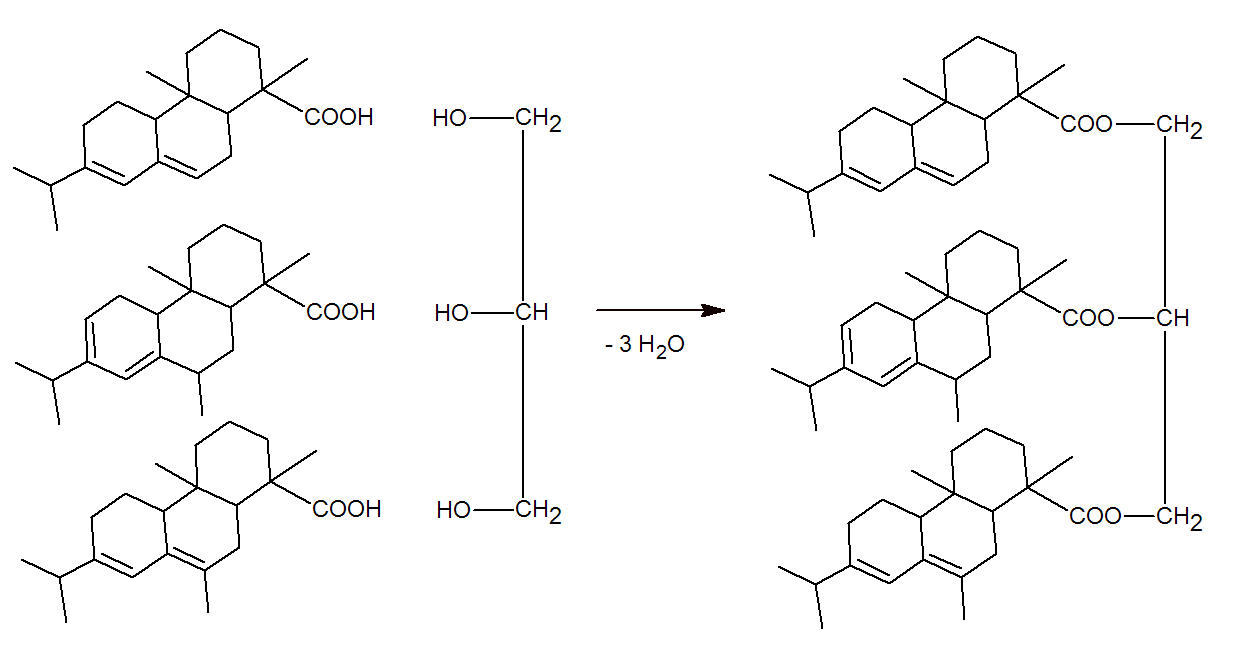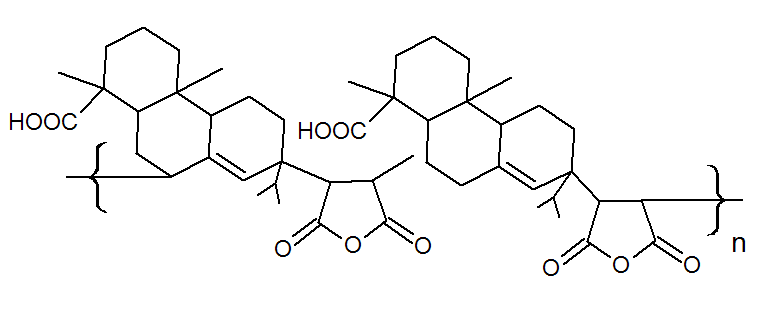Rosin Esters and Polymers
Properties
Rosin, also called resin acid or colophony, is a natural occurring resin derived from pine and spruce trees. Unlike carbon resins, rosin is not a polymer but a complex mixture of high MW acidic molecules including abietic and pimaric type acids (see below). They are important (oligomeric) additives for plastics, rubbers and related products (adhesives / coatings). The three most important types are gum rosin, wood rosin, and tall oil rosin.
Gum Rosin Is the oldest commercial sources of rosin and one of the oldest resinous raw materials. The raw resin is the exudate of plants and trees. Commercial gum resin is harvested from pine trees by periodically wounding the tree and collecting the sap.1
Wood rosin is harvested from the stump of pine trees by multiple extraction and distillation to gain food-grade gum. It can be produced in color grades comparable to gum grades and is used for similar applications.
Tall oil rosin is a by-product of the Kraft process of wood pulp manufacture when pulping pine trees. It is one of the main by-products after lignin and hemicellulose. Tall oil resin has a stronger odor and contains noticeable amounts of sulfur but when highly distilled has properties similar to wood and gum rosin.

Rosins have poor stability due to the unsaturation. When exposed to oxygen, they become dark and lose their adhesive properties. To improve their oxidative stability they are often treated by disproportionation and hydrogenation. After purification they are usually converted to esters, because only the esters are compatible with rubbers. Important commercial esters include glycerol, methyl triethylene glycol, and pentaerythriolesters.

In recent past, a lot research focused on the development of antibacterial polymers to prevent bacterial growth and contamination of food, beverages as well as medical devices and implants. Rosin ester based or modified polymers seem an obvious choice because they have antibacterial properties. The polymers can be divided into main-chain and side-chain polymers according to the position of the hydrophenanthrene structure in the polymer. So far, only low molecular weight main-chain polymers have been obtained, whereas side-chain polymerization by radical mechanism is not limited to low molecular weight polymers. It has been shown that rosin ester substituted polyesters have excellent biocompatibility, hydrophobicity, and good antibacterial activity.2 Resin acids have also been copolymerized with vinyl polymers via a free radical mechanism. For example, rosin has been reacted with maleic anhydride. A high temperature promotes a Diels-Alder reaction between the two monomers and produces a low MW polymer.3

COMMERCIAL Rosin Products
Rosin and its derivatives are commercially available in large quantities. Some major manufacturers and suppliers of these resins are Foreverest, Pinova, and Arakawa Chemicals among several other companies.
APPLICATIONS
Rosin esters are compatible with many polymers and are very effective tackifiers. However, they are somewhat more expensive than hydrocarbon resins but cheaper than polyterpenes. Because of their superior stickiness, rosin esters are widely used as tackifiers in a wide variety of products including sealants, hot melts, pressure sensitive adhesives, printing inks, vanishes and lacquers. To the later three, it adds shine and hardness. Rosin and its esters are also used in certain food and beverages, chewing gum, plastics, and rubbers as well as in detergents, cosmetics and pharmaceuticals. They function as tackifiers, adhesion promoters, emulsifiers, dispersant agents, performance modifiers (rubber), antibacterial and antifouling agents. Rosin esters have also received a lot attention as a renewal resource in polymer synthesis. However, these polymers have found only limited use so far.
1The resin obtained from trees of the genus Boswellia is known as Frankincense or olibanum. It is produced in Somalia, Eritrea, and Kenia and traded all over the Arabian Peninsula and North Africa. Frankincense has a pleasing odor. The essential oil is produced by steam distillation of the virgin resin. It is used in perfumes, burning incenses, pharmaceuticals, flavors, and skin care products. Another noteworthy rosin is myrrh which is harvested from commiphora trees and shrubs (mainly C. Myrrha). It has similar uses.
2Y. Chen et al., RSC Advances, 2, 10275-10282 (2012)
3EP 0341956 A2, Copolymers of Resin Acid and Maleic Anhydride (1986)